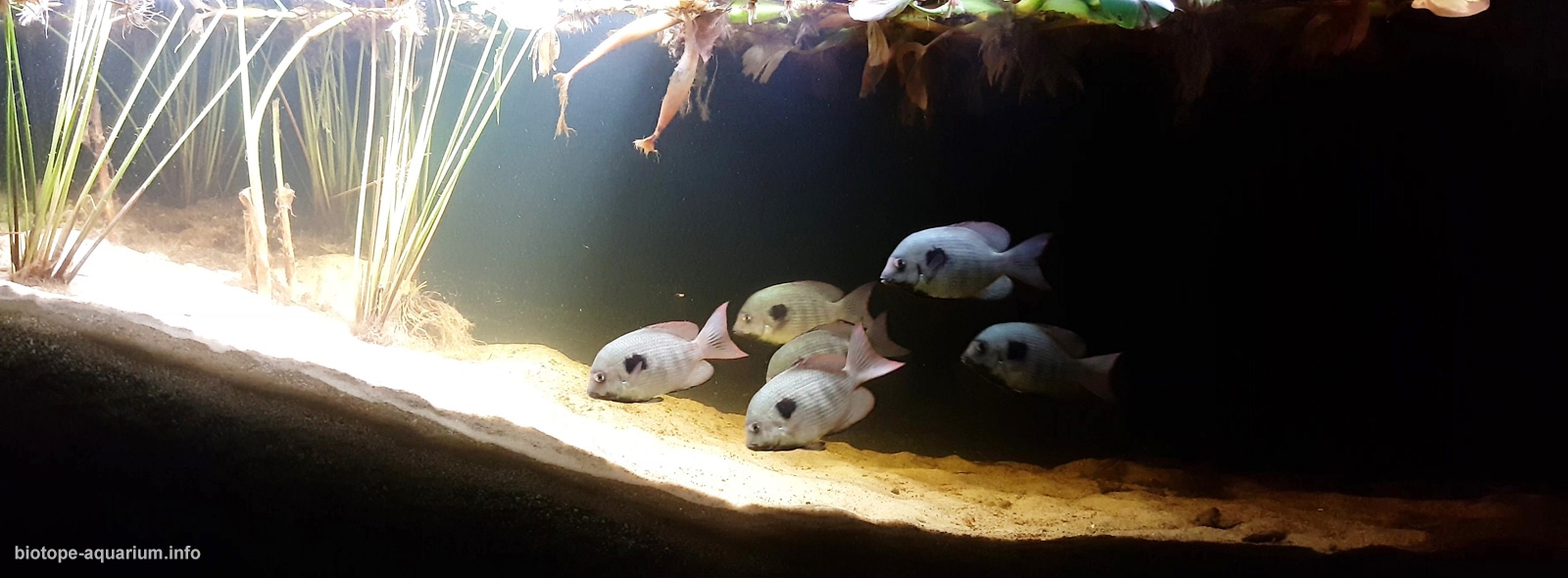Lake Ravelobe, Ankarafantsika National Park, west of Madagascar
34th place in Biotope Aquarium Design Contest 2018
![]() Poland. Paweł Łukasz Kocik
Poland. Paweł Łukasz Kocik

Volume: 840 L
Dimensions: 200x60x70 cm
List of fishes: Paretroplus maculatus
List of plants: Eichhornia crassipes, Cyperus prolifer, Typhonodorum lindleyanum, Salvinia hastata
Description of decorations: This is my favorite aquarium and I worked a lot for this setup, especially in creating the slope of the lake on the left side, I used large stones covered later with 200kg coarse gravel, fine gravel, coarse sand, thin clay that also nut color natural and fine sand that for pool filters. After finishing all the work I added my marsh plants that have liked a lot of substratum making new leaves. Only floating plants suffer continuous pinches from fish.
Description of equipment: Filtration of water is entrusted to Phytofilter installed above aquarium and masked as river edge. To move water to the surface use JBL CristalProfi e1901, in the aquariums do not use heaters because it warms up in the fishroom. Under the aquarium there is another 350 Liters and are combined with filtration and the same water that circulates in all two aquariums. 2x Easy LED Acquatlantis 6800K with dimmer sunrise and sunset.
Water parameters: Temperature is 26/27°C in summer, while in winter it drops to 25°C, Ph 7,0-7,5, GH 14, KH 7.
INFORMATION ABOUT BIOTOPE
Description of the area surrounding the biotope: The Ankarafantsika National Park is a protected natural area of ??Madagascar located in the Boeny region, in the province of Mahajanga. The park is newly established and preserves many endemic plant and animal species. The park area, which lies about 450 km north-west of Antananarivo, consists of a calcareous massif, about 300 m above sea level, which rises in the middle of a plain located at 60-90 m asl, with large areas sandy. The Mahajamba River marks the northeastern border of the park. Numerous waterways and lakes, including the Ravelobe lake also called the sacred lake. Spread over 23 hectares Lake Ravelobe carries the mystery of its own name.The lake is sacred to the Sakalava people. Visitors have the opportunity to visit a doany, a place where the Sakalava perform their sacred joro ritual. The joro takes place once a year, usually in July. During the ritual the Sakalava blesses the ancestors and subsequently admires the sacred lake. Every year the zebus are sacrificed to the crocodiles, which have a special name mampisento like an ancient people. Until today the lake is sacred and pork is not allowed in the area, as the Marambitsy were Muslims. Ravelobe was a Malagasy patriot who decided to take his own life and that of his family and bury them beneath the waters of the lake. The local population considers the crocodile to be found there as the descendants of the legendary figure of Ravelobe, in fact it forbids swimming two to the presence of crocodiles. Lake is an example of how man can destroy a natural habitat in a Protected National Park, not only with agriculture, construction, introduction of invasive plants and fish, etc. but with a tradition of the local people. Lake Ravelobe, one of the last strongholds of the Paretroplus maculatus, is now covered with invasive water hyacinth, full of introduced tilapia and crocs. Near the shore complex structures of open docks that P. maculatus used to create their nests simply no longer exist. With the loss of that habitat, they seem to have lost them too.
Description of the underwater landscape of the biotope: The maximum depth of the lake varies from 10 m (in the rainy season) to 4.10 m (in the dry season) The soil is clay-sandy to sandy-clay. On a temporarily flooded area, in the center-north of the lake, a sandy sediment of 80 cm is found, deviating water from the river that enters Lake. Underneath the areas covered with hyacinth there is no more life where the flora of the lake has been drowned in more floating islands of hyacinth create deep darkness, which favors optimal conditions to the crocodile id hunt fish. I am sure that the disappearance of the fish from the lake and the work of the crocodiles, we remember that Paretroplus Maculatus adult almost reaches 30cm and certainly a good bite for them. Searching the internet you can find news that in the area where the lake is plaguing 5/7 people per year due to crocs.
Description of the parameters of the habitat: The pH of the lake water ranges from 5.5 to 6.8. The average maximum water temperature is 26.33°C. Conductivity is equal to 160 µS/cm. The climate is composed of two wet and dry seasons. The average annual rainfall is 600 mm to 1500 mm, with a wet to dry season of 6 months.
List of fishes and invertebrates occurring in the nature biotope: N/A
List of plants found in the nature biotope: Azolla pinnata (Ramilamina) Azollaceae Hydrophyte, Eichhornia crassipes (tsikafona) Pontederiaceae Hydrophyte, Aeschynomene elaphroxylon Fabaceae Helophyte, Aniseia martiniscensis Convolvulaceae Helophyte, Colocasia aquorum (saonjo dia) Araceae Helophyte, Crinum firmifolium (Kongatsy) Amaryllidaceae Helophyte, Cyperus prolifer Cyperaceae Helophyte, Cyperus aesculentus Cyperaceae Helophyte, Floscopa glomerata Commelinaceae Helophyte, Ipomoea indica Convolvulaceae Liane Helophyte, Lemna perpusilla Lemnaceae Hydrophyte, Ludwigia diffusa Onagraceae Hydrophyte, Ludwigia leptocarpa (Rajamena) Onagraceae Helophyte, Ludwigia octovalvis Onagraceae Helophyte, Mimosa pudica (Roitry) Fabaceae Helophyte, Nymphaea stellata (voahirana) Nympheaceae Hydrophyte, Neptunia oleracea Fabaceae Helophyte, Panicum maximum Poaceae Helophyte, Phragmites mauritianus (Bararata) Poaceae Helophyte, Pneumatopteris unita Thelypteridaceae Helophyte, Polygonum glabrum (Fotsimbarin’akoholahy) Polygonaceae Helophyte, Polygonum mite Polygonaceae Helophyte, Raphia farinifera (Rafia) Arecaceae Helophyte, Typha angustifolia (Vondrona) Typhaceae Helophyte, Typhonodorum lindleyanum (Viha) Araceae Helophyte, Pycreus mundtii Cyperaceae Helophyte, Salvinia hastata Salviniaceae Hydrophyte, Ceratopteris cornuta Pteridaceae Hydrophyte, Utricularia gibba Lentibulariceae Hydrophyte.
Threats to the ecology: During the last ten years, the spread of hyacinth caused ecological and hydro-agricultural crises in Africa It was introduced in Madagascar around 1900 as an ornamental plant in the capital and then found in a private collection in Toamasina and Mahajanga. Then, it became a significant threat to Madagascar’s wetlands, particularly Alaotra Lake and the Pangalanes Canal to the east. In addition, a problem of conservation of biodiversity is posed by hyacinth. This is the case at Lake Ravelobe, which is a refuge for many endemic endangered species such as the endemic turtle Erymnochelys madagascariensis, the fish Paretroplus maculatus (damba), the birds Haliaetus vociferoides, Butorides striatus, Amaurornis olivaceus and the lemur Microcebus ravelobensis . These endemic endangered species depend on the macrophytes of Lake Ravelobe. To quote and Erymnochelys madagascariensis, which feeds on the green roots and stems of Phragmites mauritianus, the fruits of Raphia farinifera, and the seeds of Typhonodorum lindleyanum. In addition to its ecological value, the lake is the water tower of the rice plain of Marovoay which is the second granary with Malagasy rice. Hyacinth is native to South America. His invasion leads to serious economic and ecological consequences Eichhornia crassipes Solms Laub belongs to the tribe of Eichhornieae, family of Pontederiaceae, order of Commelinales, subclass of Commelinidae, classes of Monocotyledons. It is a floating free aquatic species, with thick, waxy, shaped leaves oval to circular, 10-20 cm in diameter, with spongy petiole. Its roots are dense feathery and more than 30 cm long. The inflorescences include 8 to 15 flowers in purplish blue to pink. The aerenchyma is reported in the tissues of the receptacle, perianth, ovary wall, placenta, stamens and connective tissue. Its biology favors its invasion, allowing it to grow very fast in different wetlands around the world. No evaluation was made of the method applied to pull the hyacinth. According to the Park officials, the work was not effective for the following reasons: (1) non-permanent grubbing; (2) The completion period is different from one tranche to another. (3) grubbing up is incomplete. (4). The work is badly done due to the lack of trust in crocodiles. There is no fixed program for watering rice fields, and the duration depends on the request of the head of agriculture in Marovoay, based on the need for water from the rice fields. It varies from a week to a month. Hyacinth can double the size of its population in 6 to 18 days. 40The variations in biomass are not negligible in the wet season (10.3 kg / m² to 27.9 kg / m²) and in the dry season (16kg / m² to 26.3 kg / m²). The hyacinth individuals are also retained between the helophytes’ feet, forming very dense tufts. Thus, recolonization is intense. In addition, the dead woods on the bank and the shape of the lake a little curved (the curved areas are sheltered from the wind), favor the installation of the hyacinth. The seeds of Typhonodorum lindleyanum are eaten by the aquatic turtle. The proliferation of Hyacinth can expand the roots of Typhonodorum, causing its rarity or even its mortality. Submerged macrophytes such as Ultricularia gibba and Nymphaea stellata are found in trace amounts in the lake, while serving as food for fish and birds. This rarity is supposed to be due to competition with hyacinth. An imbalance is created in the aquatic microsystem and the species whose existence is linked to the existing ecosystem, are threatened with extinction.
Sources of information:
https://www.lemurconservationnetwork.org/ankarafantsika-national-park-and-the-legend-of-lac-ravelobe/
https://scientistatwork.blogs.nytimes.com/2011/07/13/returning-upriver-with-very-few-fish/
https://scientistatwork.blogs.nytimes.com/2011/06/28/changes-in-madagascars-rivers-and-lakes/
https://guide.mg/tourisme/parcs/ankarafantsika
https://www.dropbox.com/s/wyyfuh0c1w7vll6/Evaluation_prolifration_Jacinthe_Ravelobe.pdf?dl=0
http://www.madacamp.com/Lake_Ravelobe
https://journals.openedition.org/vertigo/13522?lang=en
http://www.iucnredlist.org/details/16236/0
https://www.cabdirect.org/cabdirect/abstract/20133366463
Comments of the members of the jury of Biotope Aquarium Design Contest 2018

I have to give a thumb up for the decent research you did on all your tanks. Designwise they might not be the best, but your choice of fish, the information you gathered: congratulations. This was the first time for me to see those beautiful fishes. They are true wonders of nature. Sadly enough their status is “critically endangered” or already extinct in the wild because of habitat destruction. Same mechanism that takes place all over the world. It makes me sad.
